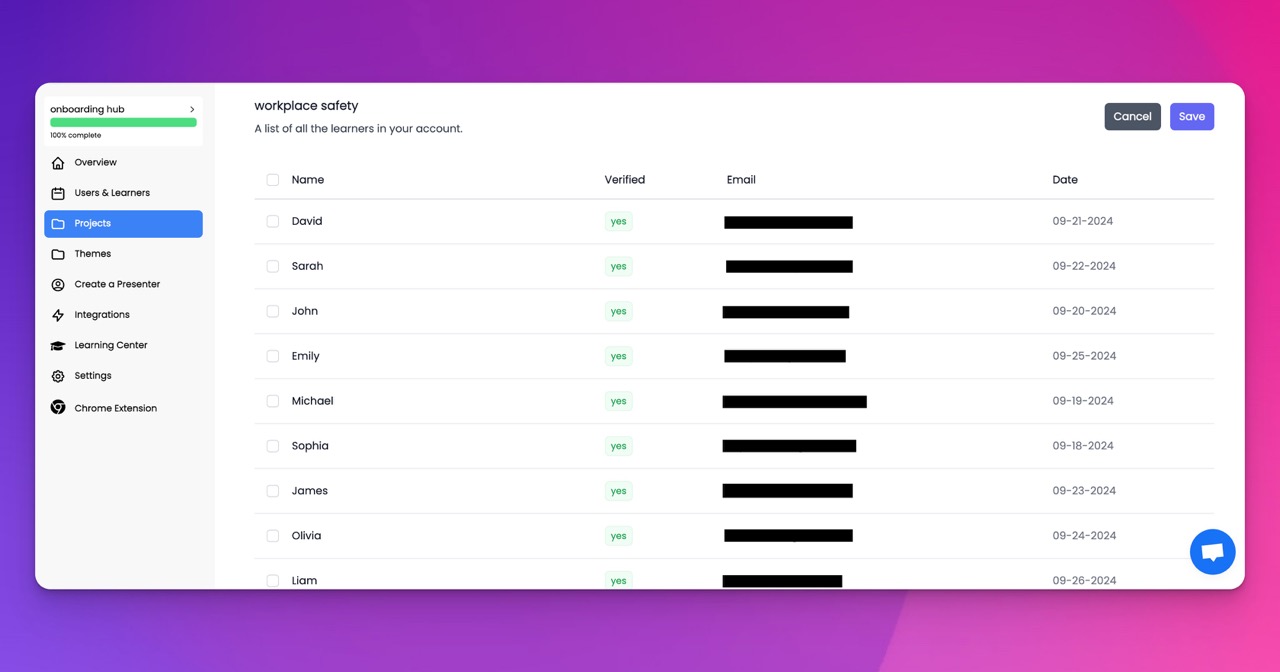🎉 Trainday now integrates with Zendesk and Hubspot 🎉 Trainday now integrates with Zendesk and Hubspot 🎉 Trainday now integrates with Zendesk and Hubspot
🎉 Trainday now integrates with Zendesk and Hubspot
🎉 Trainday now integrates with Zendesk and Hubspot
Contact
Focused Learning, Safer Workplaces - The Benefits of Microlearning in Safety Programs
Workplace safety is more than just compliance—it’s a culture that prioritizes the well-being of employees and ensures smooth operations. Yet, traditional safety programs often struggle to make a lasting impact. Overwhelming employees with lengthy training sessions and dense materials can lead to disengagement and low retention.
Microlearning offers a solution. By focusing on delivering small, targeted lessons, microlearning transforms safety programs into more effective, engaging, and impactful experiences. Let’s explore how this approach creates safer workplaces by making learning focused and actionable.
What is Microlearning?
Microlearning delivers training content in short, digestible modules—typically lasting 3 to 10 minutes. Each module focuses on a specific topic or skill, making it easier for employees to understand and apply what they’ve learned. These lessons are presented in engaging formats such as videos, quizzes, infographics, and interactive scenarios, ensuring employees stay motivated and retain critical information.
When integrated into safety programs, microlearning empowers employees to grasp key safety protocols and apply them effectively in real-world situations.
How Microlearning Enhances Safety Programs
1. Improves Knowledge Retention
Safety training often involves critical procedures and protocols that employees must remember and follow under pressure. Traditional methods can overwhelm learners with too much information at once, leading to poor retention. Microlearning breaks down complex safety topics into smaller, focused lessons that are easier to process and remember.
For example, instead of a single lengthy session on workplace safety, employees might complete several modules covering:
How to identify hazards
Correct use of personal protective equipment (PPE)
Emergency response procedures
This focused approach ensures employees retain the knowledge they need to work safely.
2. Boosts Employee Engagement
Traditional safety programs often suffer from low engagement. Sitting through hours of static presentations or reading through dense manuals can make employees lose interest. Microlearning addresses this challenge by using interactive, visually appealing content to keep learners engaged.
Gamification elements like quizzes and progress tracking, as well as real-world scenarios, transform safety training into an active, enjoyable process. When employees are engaged, they’re more likely to internalize and apply what they’ve learned.
3. Supports Just-in-Time Learning
Microlearning’s flexibility allows employees to access safety training exactly when they need it. Whether they’re preparing to use new equipment or facing a unique hazard, quick, targeted lessons provide the knowledge they need in real-time.
For instance, a warehouse worker encountering a spill could review a 5-minute module on spill containment and cleanup procedures before acting. This real-time application reinforces learning and minimizes risks.
4. Fits Into Busy Schedules
In many workplaces, finding time for lengthy training sessions can disrupt productivity. Microlearning solves this problem by delivering short lessons that employees can complete during breaks or between tasks. Mobile-friendly modules make it easy for employees to access training on-the-go, ensuring safety education doesn’t interfere with daily operations.
This flexibility helps businesses maintain productivity while ensuring employees are equipped with essential safety knowledge.
5. Tailored to Specific Roles and Risks
Every workplace and role comes with unique safety challenges. Microlearning enables organizations to customize training content to meet these specific needs. Employees receive lessons relevant to their responsibilities, making training more impactful and practical.
Examples include:
Construction Workers: Modules on fall prevention and equipment safety
Healthcare Professionals: Lessons on infection control and patient handling
Office Employees: Training on fire evacuation and ergonomic practices
This targeted approach ensures employees are prepared for the safety risks they’re most likely to encounter.
6. Promotes Continuous Learning
Safety isn’t a one-time lesson—it’s a continuous commitment. Microlearning supports ongoing education by providing refresher modules and updates on new protocols. Spaced repetition ensures employees revisit critical concepts regularly, keeping safety knowledge fresh and actionable.
This culture of continuous learning strengthens workplace safety and reduces the likelihood of complacency.
Real-World Applications of Microlearning in Safety Programs
Onboarding New Hires Help new employees quickly learn essential safety protocols through targeted lessons tailored to their roles.
Compliance Training Ensure employees stay up-to-date with industry regulations through concise, focused modules.
Emergency Preparedness Equip employees with the knowledge to respond effectively to emergencies, from fire evacuations to medical incidents.
Skill Refreshers Reinforce existing safety knowledge through regular refresher courses, reducing the risk of accidents caused by forgotten protocols.
Benefits of Microlearning in Safety Programs
Fewer Workplace Incidents: Better retention and real-time application reduce accidents and injuries.
Higher Compliance Rates: Focused, engaging lessons ensure employees understand and adhere to safety regulations.
Increased Productivity: Flexible, on-the-go training minimizes downtime while equipping employees with essential knowledge.
Cost-Effective: Short, scalable modules reduce training costs while delivering high-impact results.
Accelerate Compliance.
Deliver OSHA-Ready Courses Instantly.
Empower your team with data-driven training solutions tailored to your industry's safety standards. Stay compliant, reduce risks, and boost productivity with AI-powered course creation.
